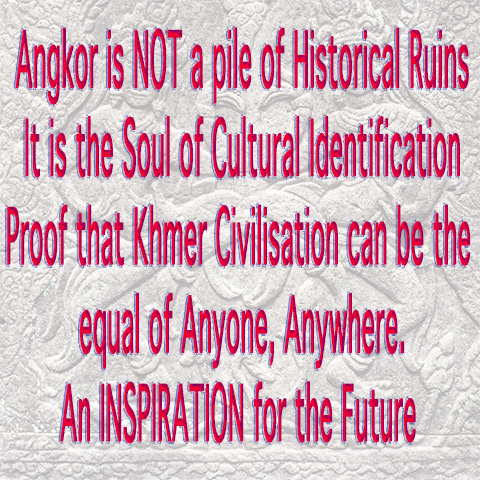

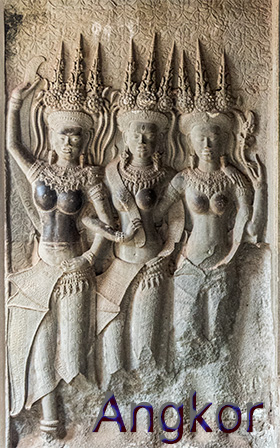
|
Angkor was the capital of the Khmer Empire from 802 to 1432. I have visited the Angkor Temples twice with a gap of 10 years between visits. Following is a description combining both visits. I bought a three day pass for $US60, $US20 dearer than my first visit. Non-transferable, it had my embedded photograph which made it a nice souvenir to take home. Now my three days of visits could be spread over 7 days. This is a vast improvement over my first visit in which visits had to be completed in three consecutive days. |
Inside the grounds of Angkor Wat I am immediately accosted by the sellers of guide books. Guide books that I cannot at this early hour even see, let alone read. Following the pre-dawn herd I made my way along the causeway and branch off of it to the right, to go to one of the libraries. Because of their slight elevation they provided a good vantage point to watch Angkor Wat being nursed into the daylight with the accompaniment of cicadas.
Silhouetted against a lightening sky are four corn cob shapes. Dozens of useless flashes fire. Light paints more detail, the corn cobs become more angular. They are the towers of the square third terrace. Soft dawn light reveals more detail, lotus plants, tower reflections in the northern basin and the first terrace featuring the gallery of bas-reliefs.

So was getting up before dawn worth it. Well from point of view of the dawn. I did not think so. However I was there the wrong time of the year. During each equinox the Sun rises behind the central tower. But even if I did not get the main prize I got a consolation prize, ascending the third terrace in the cool air of morning instead of later in the day.
I walked along the causeway and into Angkor Wat. Like the first time, I am not now interested in the bas-reliefs. Now as then the morning air is cool and I again journey to the third terrace of the cosmic mountain, where only Kings and high priests once ascended. Mere plebians like myself were restricted to the ground level court yards.

The number who can be at the top at any given time is now restricted. Thankfully the wait is not long. Wooden stairs now cover the stone stairs. An welcome addition, making the climb to the top much easier and also protecting the stone stairs. Climbing, during my first visit, from the second to the third terrace was a humbling experience requiring arms and legs, more like a monkey than a man. From the top a good view was provided of the surrounding country.
Leaving Angkor Wat, which I will visit again later in the day, I re-enter the remorque and the driver takes me to Angkor Thom. On my first visit I used an air-conditioned car but I think the remorque is a more suitable vehicle.
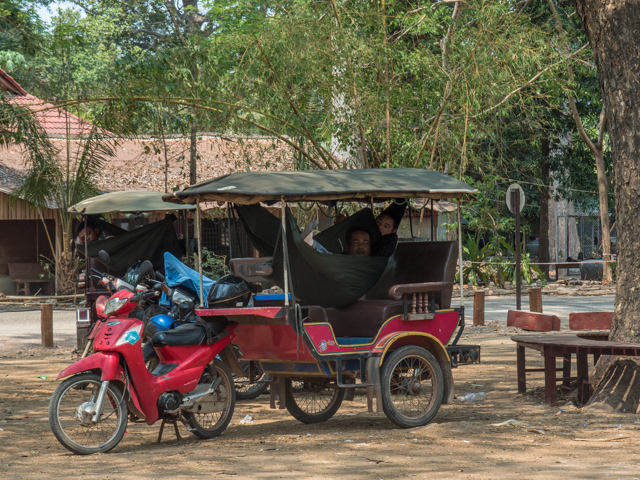
Angkor Thom, meaning 'Great City' encloses an area of 9 sq kilometers. Unlike Angkor Wat it is a Buddhist structure. Built by Jayavarman VII (reign: 1181-1219) around 1200 its population may have been over 100,000. The south gate entrance is approached along a causeway lined by a total of 108 large statues, Gods on one side and Demons on the other. Each are engaged in a tug-of-war with a nine headed Naga. The causeway is symbolic, a rainbow bridge linking the world of humans to the world of the Gods.
The path to the Bayon passes through a 23 meter high portal, high enough to let through a full-laden Royal Elephant. The tower gate is topped by four faces facing in cardinal compass directions. This is the Buddhist Lord who looks in every direction.

Entering through the portal, from a distance the Bayon appears as a pile of stones. Moving closer, heads take form. The pattern of four heads facing in the four directions is repeated multiple times.


Like Angkor Wat the Bayon also has bas-reliefs. They depict elephants, domestic life and battles with the Chams.

Near the Bayon are the Royal Terraces. The Elephant terrace, named after frieze featuring life sized elephants which might have been used by the royal family to watch events in a nearby open square. The Leper King Terrace, nearby, was restored by the anastylosis method in the 1990's, by assembling friezes. Anastylosis is a process by which restoration is acheived by using the original materials.
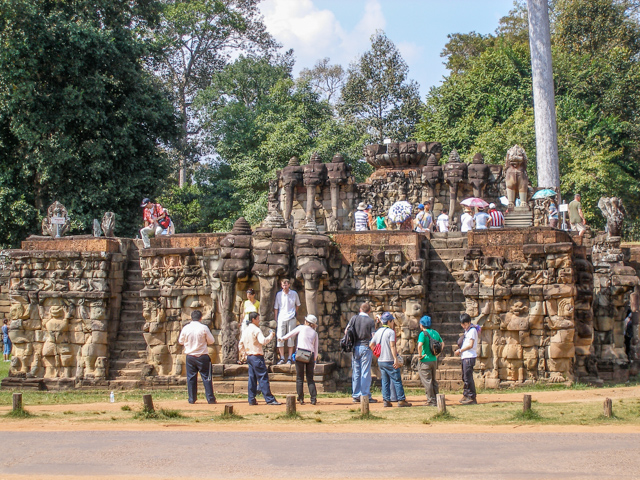
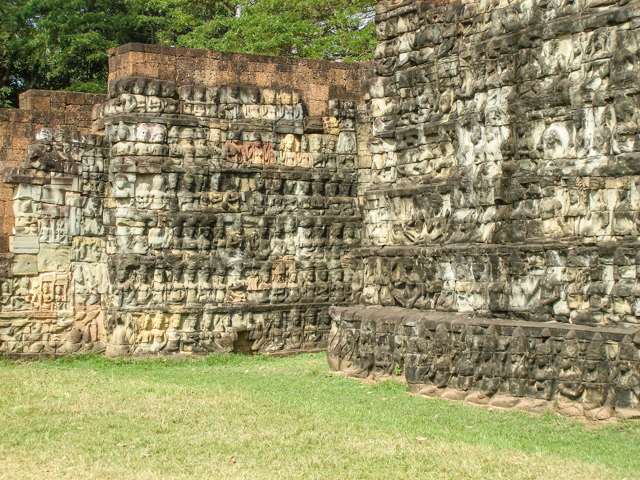
Lunch was taken at a open air cafe near the entrance of Angkor Wat. Lunch for the next two days will be taken here. Each time I am accompanied by children aged between 8-11 trying to sellpost cards and bangles. I ask them why aren't they at school, and they reply, in quite passable english, that they attend school for 1/2 day, some in the morning and some in the afternoon. Once, when a child was is by herself I bought some postcards, ten for a dollar, and then gave them back to her, the transaction completed before she was rejoined by her competitors.

Remainder of this first temple visiting day is spent back at Angkor Wat.
Angkor Wat, which took about 30years to construct, was built during the reign of King Suryavarman II(1113-1145/50). It was dedicated to the Hindu God, Vishnu.
Angkor Wat consists of 3 rectangular terraces located above each other in a pyramidal fashion. The first terrace 200 metres x 180 metres and 4 metres off the ground. Bas-reliefs surround the first terrace.
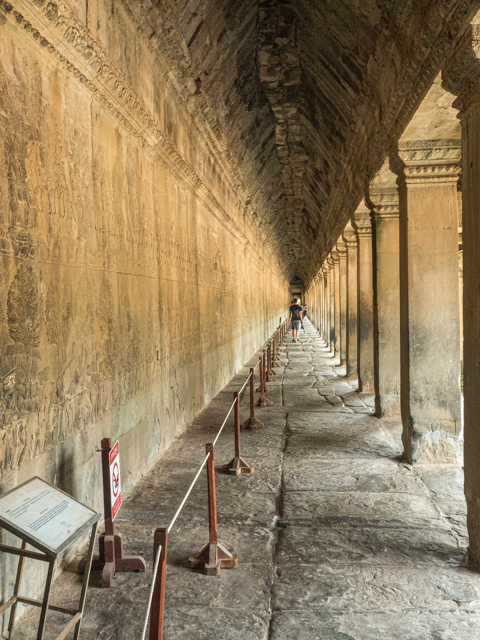
They tell stories of the Churning Sea of Milk, the Hindu creation myth; stories of the Ramayana epic; of battle; of damnation in hell, including stavation, beatings and elephant assaults. Many of the traditional dances lost in the insanity of the Pol Pot years have been recreated from the bas-reliefs.
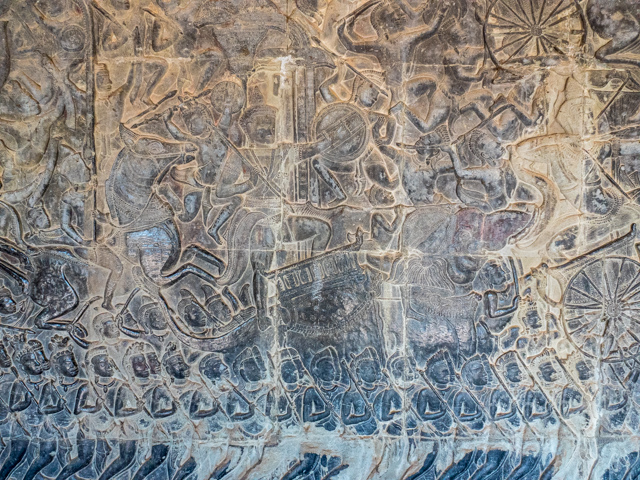
Measuring 60meters square and 13meters higher than the first terrace, the second terrace is where images of apsaras are located. In Hindu mythology apsaras are supernatural beings, taking the shapes of beautiful and elegant young women, skilled in the art of seductive dancing. Living in Indra's heaven they are sent by him to seduce any ascetics who might try to challenge his power. Over 1800 are carved into the walls of Angkor Wat, each with her own customes, jewerelly, hair dress and individual features.
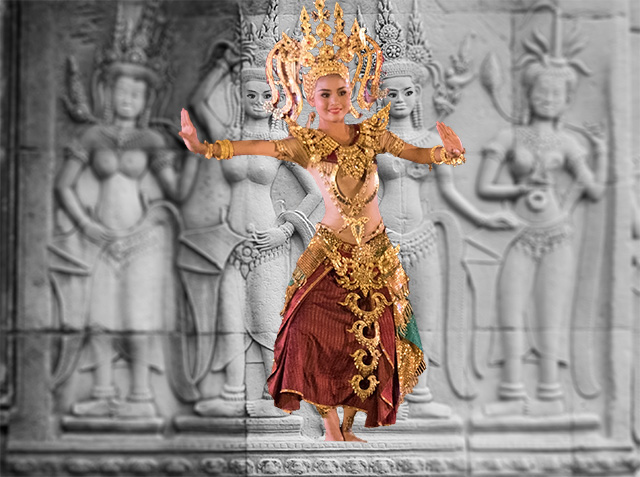

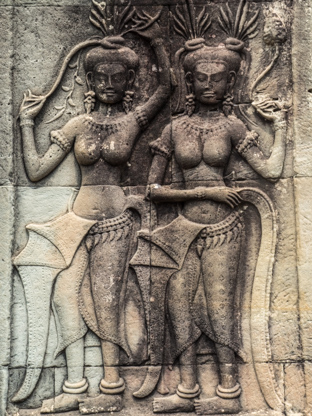
Another characteristic of the second terrace is the baluster windows with seven twisted columns.

The third and final terrace is called the Quincunx Terrace because it is square and supporting five towers. The central tower, symbolic of the center of the Hindu Cosmology, Mt Meru, is 65m high. I am pleased that I climbed to this terrace in the cool of early morning and now in the heat of a humid afternoon I am content to mingle, take photographs and let others join the now much longer queue.
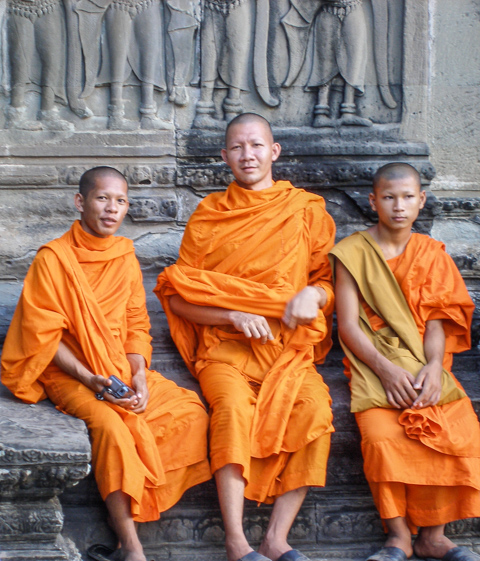
Leaving Angkor Wat I am approached by dancers wishing to take a photographs of me posing with them for a dollar. I agree but with the proviso that I will not be in the picture.

Angkor has hundreds of temples. Trying to see them all in three days is a futile exercise. So I made the decision just to visit a few.
I realised that in addition to hat, sunglasses and drinking water I needed a scarf to cover the back of my neck. It was easily obtained from one of the many vendors.
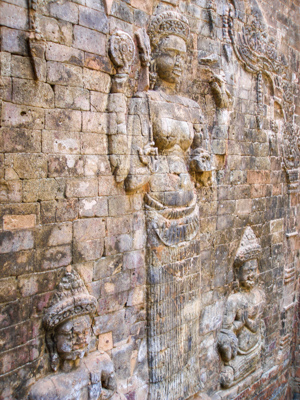
Prasat Kraven, consisting of five sanctuary towers lined in a north-south direction and facing east was built around 921. Its well manicured 'lawns' and rectangular shape reminded me of European structures. Made of bricks, a vegetable gum was used as a binder. Inside the towers are images dedicated to Vishnu, presented in the form of a brick bas-reliefs, a form not see anywhere else in Angkor. It is possible that these reliefs may have been coated with stucco and painted.

Jayavarman VII, who was a Mahayana Buddhist, built three monastic temples, Ta Prohm, Preah Khan and Bantey Kdei.
Ta Prohm, first of the monastic temples, built around 1186, was dedicated to Jayavarman VII's mother. I entered its grounds via the Western Gate.

Flat in design it is surrounded by five enclosing walls. It is believed 12000 people, including 600 dancers lived within it walls and they were supported by another 80,000 who lived outside. Wealthy, amongst its riches were over 500 kilograms of golden dishes, 35 diamonds and over 40,000 pearls.
Jayavarman VII was said to have built more structures the all the other Khmer Kings put together. So much building meant many were hastily built and their decorations incomplete. Note the incomplete decoratons on the false door, left side, in the image below.

After Jayavarman's death some of its artwork was destroyed during a Hindu revival.
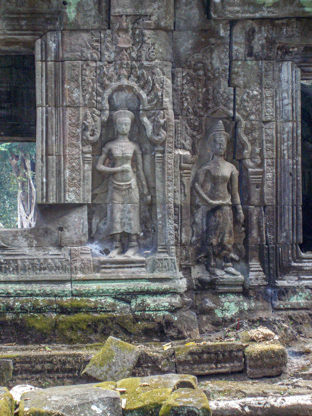

Abandoned after the collapse of the Khmer Empire it was deliberately left unrestored.

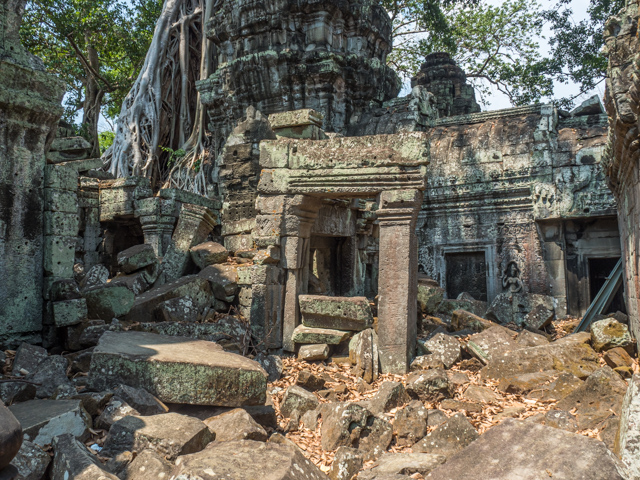
Preah Khan, larger then TaProhm, was dedicated by Jayavarman VII to his father. Covering 57 hectares and surrounded by a 3 kilometre laterite wall, the complex served as a monastery and a religious college. It has an extensive baray system, including Jayatataka baray, which contains the small Buddhist temple, Neak Pean. Maintanance required a staff of 100,000 men and women from neighbouring villages.
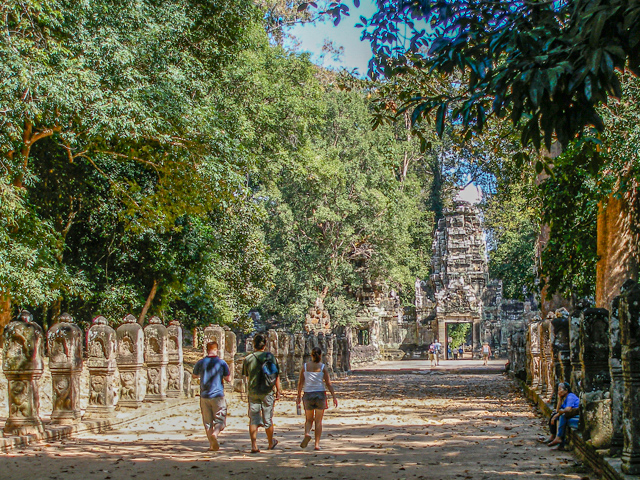
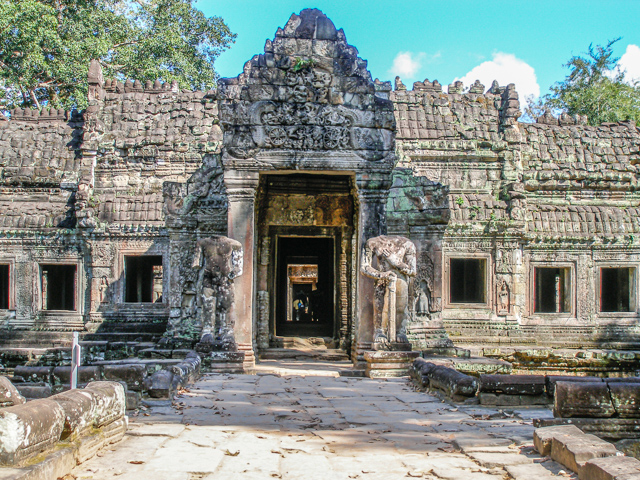
Crossing the moat I approached the headless guards. Suspecting they would not see me I pass them and enter the hall way which takes me deep into the interior. Passages branch off from the main hallway. Some of them lead nowhere, others are blocked by large stones. I finally reached the Hall of Dancers.
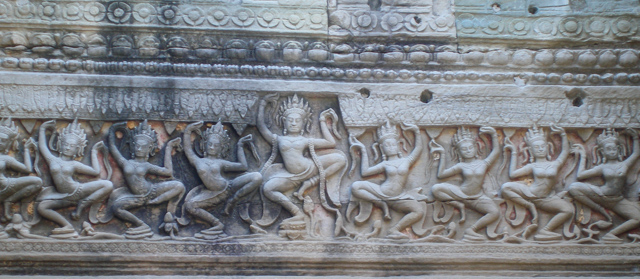

Throughout his reign Jayavarman VII built over 100 dharmashala, or resting places for Buddhist pilgrims. This one, inside the walls of Preah Khan, is along the road that leads to the temple. Windows were generally on one side, the road side. He also built roadside hospitals.


Banteay Kdei is the smallest of the three Buddhist Monasitic temples built by Jayavarman VII in Angkor. It is approached by walking along a long wide path bordered by trees. You may be accompanied by singing cicadas. Once inside the grounds you see that it has not been restored. Originally built of soft sandstone, arches and walls have collapsed and much of its masonary is randomly spread around the grounds. Standing structures in many areas have a green covering due to the growth of lichens. But amongst the neglected decay are many fine statues of feminine dieties embedded in the walls.




In the baray of Preah Khan, Jayatataka, is Neak Pean. It is a small Buddhist temple on a circular island in the center of the baray. It has large central pool, 70 meters square, surrounded by four smaller square pools. The central pool represents the mythical Lake Anavetapter in the Himalayas, center of the Buddhist Universe, source for India's four great rivers and where divine beings bathed. Located in the center are two coiled cobras, joined at the tail but separated at the head, allowing access from the east side. Top of the prasat is crowned by a lotus. This is dedicated to the bodhisattva Lokesvara. During its hey day the pool was covered in lotus plant. The approaching horse, Balahu is an incarnation of Lokesvara. Legend has it that Lokesvara morphed into a horse to recue shipwreacked merchants off the coast of Sri Lanka. It also symbolises crossing the sea of rebirths.

Returning along the same path I once again come across four men playing music. They are victims, among many, of land mines, trying to collect money. It is estimated there are over 40,000 people with land mine injuries in Cambodia. In addition a large number have died, mainly from blood lost. The vast majority of victims are young adult males. So a donation, considerabley more than the token dollar, was given.
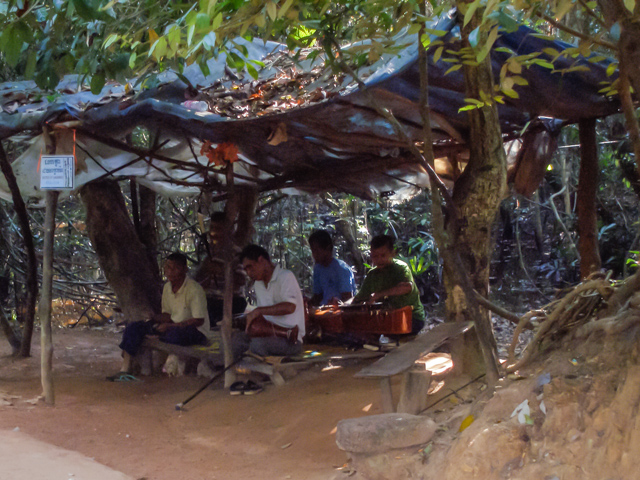
First temple visited on this, the third day of temple exploration, is Banteay Srei, 50 kilometers from Siem Reap.
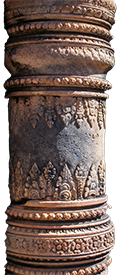
|
Founded in 967 by Brahman priests it was the first temple in Angkor to be restored by the process of analytosis. Built from hard pink sandstone it is eleborately decorated with embedded carvings representing Indian epics particularly the Ramayana and with carvings of foliage which cover also all of the available surface. Faces peering out of the foliage represent male and female spirits. A small temple but the most decorated temple complex I have seen in the vicinity of Angkor. |
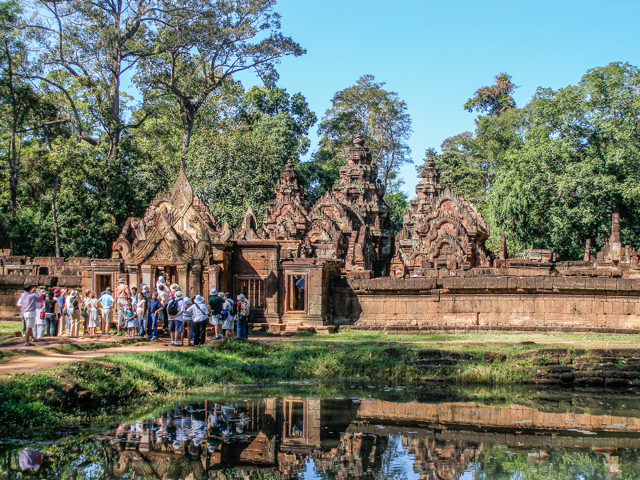
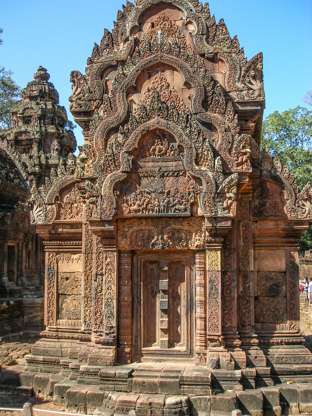
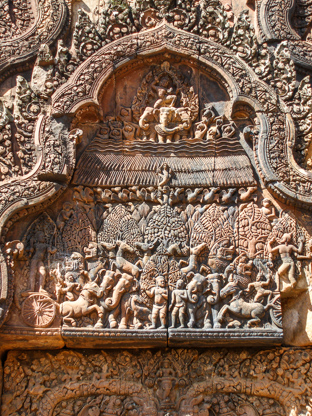
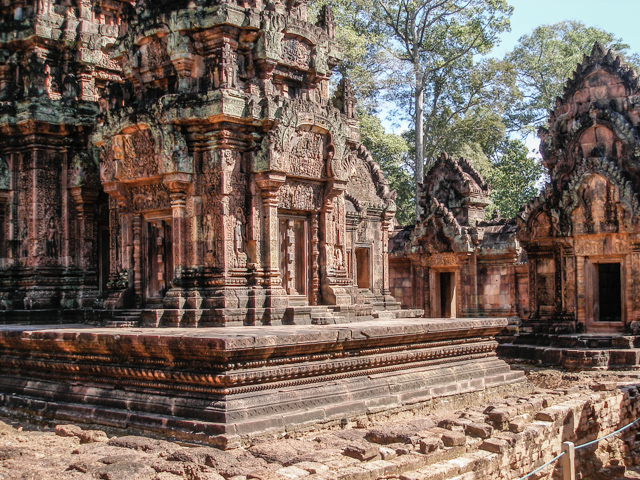
We visit Banteay Samre on the way back from Banteay Srei. To do it this way is not necessary as it is quite close the other visited temples.
A Hindu temple, dedicated to Vishu, it was built by Suryavarman II between 1140-1165. It was restored in the 1930s by the French using anastylosis.
Passing through the entrance into the first enclosure I enterd a court yard which today is covered with lawn. Pediments are highly decorated often featuring scenes from the Hindu epic, the Ramayana.
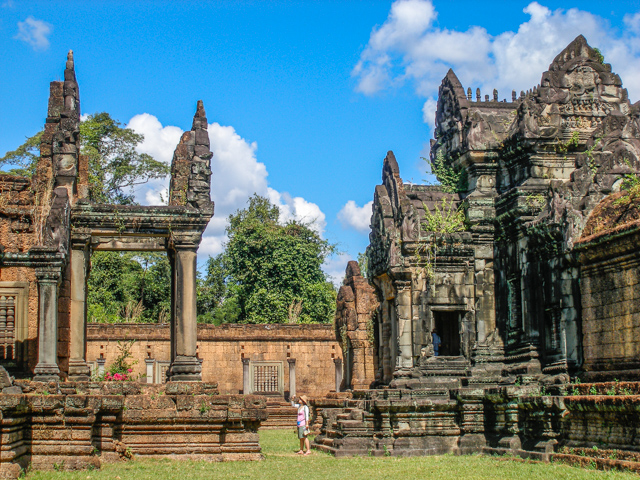

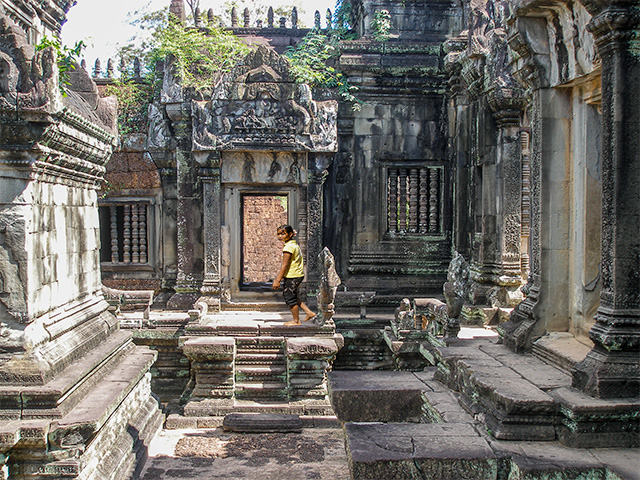
My final destination in Siem Reap is an cultural arts center, one of several workshops that have been set up to revive arts and crafts of the Khmer Empire (801- 1432).
People between the ages of 18-25 are selected from surrounding villages and trained in groups of 20-30 for up to 8 months. Arts/crafts taught are stone and wood carving, lacquering, silk processing, ceramics and silver work. Purpose is three fold, to revive the arts of the Khmer Empire; to provide employment for villagers; to try to combat the theft of tradition Khmer art.
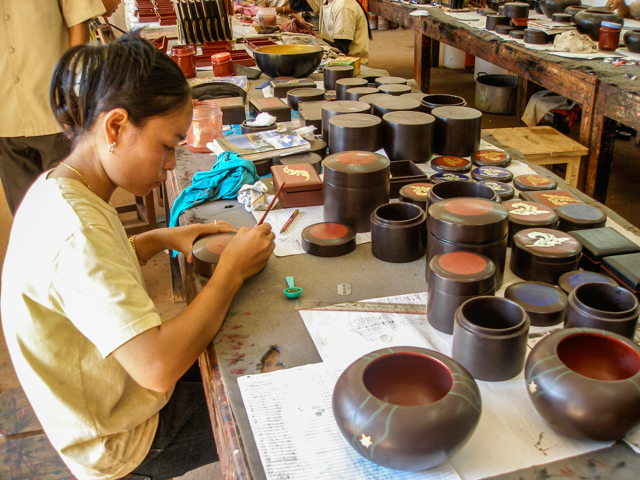
Of course a guide voluteered to give me a tour, which I accepted. Nearing the end of my trip I actually lash out and buy a piece of silverware, a little cylindrial container with a bas-relief elephant on the lid. What I will use it for, I have absolutely no idea. Art on the mantle, I suspect.
How much should I tip the guide? I am not sure, too much could make a mockery of people's wages, so I ask one of the girls. She answers $US2. So I paid the guide $US2 for his 15-20 minute spiel.
